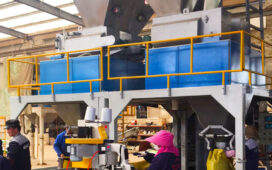Strapping machines have emerged as indispensable tools in the industrial sector, revolutionizing the way goods are secured and transported. These automated devices have transformed packaging processes, offering a myriad of benefits that optimize efficiency and enhance security. By automating the once time-consuming and labor-intensive task of applying straps to packages, these machines streamline operations, allowing businesses to allocate human resources to more complex tasks. With their high-speed operation and precision, these machines ensure consistent strapping quality, reducing the risk of human error. Moreover, they provide robust protection for goods during storage and transportation, preventing damage, minimizing financial losses, and enhancing customer satisfaction.
Streamlining Packaging Processes:
Strapping machines streamline packaging processes by automating the time-consuming and labor-intensive task of applying straps to packages. With their high-speed operation and precision, these machines significantly increase efficiency while ensuring consistent strapping quality. Industrial facilities can eliminate human error, maximize efficiency, and reallocate human resources to more difficult jobs by doing away with the requirement for physical labor.
Ensuring Product Protection:
Making sure that commodities are protected during storage and transit is one of the main goals of strapping machines. These machines use strong straps composed of materials like steel, polyester, or polypropylene that are exceptionally strong and resistant to outside influences. Machines for strapping packages tightly reduce the possibility of damage, stop moving, and lessen the possibility of product loss or breakage. This raises client happiness while reducing the financial cost of damaged goods.
Enhancing Load Stability:
For the safe and effective transportation of products, load stability is essential. By firmly coupling packages, minimising movement, and limiting shifting during transit, strapping devices significantly contribute to improving load stability. By preventing mishaps like load collapse and spills, both the safety of the workers and the products is ensured. Additionally, improved load stability reduces the need for excessive packaging materials, resulting in cost savings and environmental benefits.
Adaptable Applications:
These machines are versatile tools that cater to a wide range of applications in diverse industries. They can handle various package sizes, shapes, and weights, accommodating the needs of industries such as logistics, manufacturing, agriculture, and construction. From bundling newspapers and magazines to securing heavy machinery or construction materials, these machines offer flexibility, making them indispensable assets for businesses operating in dynamic environments.
Customizable Strapping Solutions:
These machines come with customizable settings and features, allowing businesses to tailor the strapping process to their specific requirements. Adjustable tension, strap width, and sealing methods provide the flexibility needed to adapt to different packaging needs. Whether it’s applying light or heavy-duty straps, using heat seals or friction welds, these machines offer versatility, ensuring optimal strapping performance for diverse industrial applications.
Conclusion:
The widespread adoption of these machines in the industrial sector has brought about remarkable improvements in efficiency, security, and customer satisfaction. By automating packaging processes and ensuring consistent strapping quality, these machines optimize productivity while reducing the risk of human error. Their ability to protect goods during storage and transportation minimizes the financial impact of damage or loss, bolstering business resilience.







